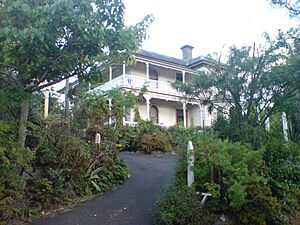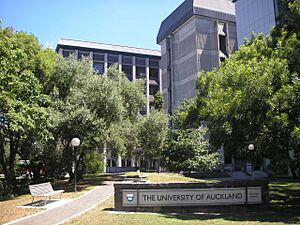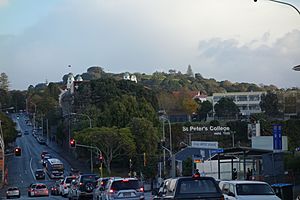Grafton, New Zealand facts for kids
Quick facts for kids
Grafton
|
|
|---|---|
|
Suburb
|
|
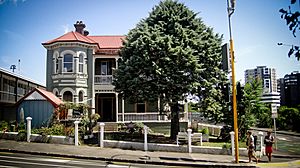
Hum Salon operating at the Basley-Bush House / Rothesay at 123 Grafton Road, February 2015
|
|
| Country | New Zealand |
| Local authority | Auckland |
| Electoral ward | Ōrākei ward |
| Local board | Waitematā Local Board |
| Area | |
| • Land | 62 ha (153 acre) |
| Population
(June 2023)
|
|
| • Total | 1,640 |
| Train station(s) | Grafton Railway Station |
| Hospitals(s) | Auckland City Hospital, Starship Hospital |
Grafton is a cool suburb in Auckland, New Zealand. It's named after the Duke of Grafton, who was a supporter of New Zealand's first Governor, William Hobson. Long ago, it was known as 'Grafton Heights' because it was a fancy area in Auckland's early days.
Contents
- About Grafton
- People in Grafton
- Schools in Grafton
- Cool Places to See
- Grafton Bridge
- Basley-Bush House (Hum Salon)
- Auckland City Hospital
- Auckland Medical School
- Auckland Domain
- Elliot Memorial Entrance Gates
- St Arvans
- Huntly House
- La Roche Villa
- Grafton Mews
- Outhwaite Park
- St Peter's College and Christian Brothers House
- Former Methodist Training College
- Phoenix Gardens
- Auckland Bowling Club
- Grafton Volcano
- Famous People from Grafton
About Grafton
Grafton is special because it has many old buildings. Lots of them look almost the same as they did in the early 1900s! Even though some parts of Grafton got smaller when new motorways were built, the remaining area feels very connected. The rules for building here even try to stop people from knocking down old houses.
Grafton has a local group called the GRA, which stands for the Grafton Residents' Association. Also, the well-known clothing brand Barkers has its main office here.
People in Grafton
Grafton covers about 0.62 square kilometers. As of June 2023, it has an estimated population of 1,640 people.
| Historical population | ||
|---|---|---|
| Year | Pop. | ±% p.a. |
| 2006 | 1,722 | — |
| 2013 | 1,878 | +1.25% |
| 2018 | 1,686 | −2.13% |
In the 2018 New Zealand census, Grafton had 1,686 people living there. The average age was 29.2 years old. About 6.9% of the people were under 15 years old.
Grafton is a very diverse place! About 60.5% of residents were European/Pākehā, 7.7% Māori, 3.9% Pacific peoples, and 34.2% Asian. Many people (48.0%) were born outside New Zealand.
When it came to religion, most people (53.0%) said they had no religion. Others were Christian (31.5%), Hindu (3.4%), Muslim (2.3%), or Buddhist (2.5%).
Many people in Grafton have a good education. About 45.9% of adults had a university degree or higher.
Schools in Grafton
St Peter's College is a Catholic school for boys in years 7 to 13 (ages 11-18). It has about 1,292 students as of February 2024. .
Cool Places to See
Grafton has many interesting landmarks and buildings.
Grafton Bridge
This huge bridge connects the Auckland city center with Grafton. When it was finished in 1910, it was the biggest reinforced concrete arched bridge in the world! It stretches for almost 300 meters.
Basley-Bush House (Hum Salon)
This historic house at 123 Grafton Road was built around 1882. It has a cool Italianate design with unique windows and chimneys. For many years, it was empty, but volunteers have now fixed it up. Today, it's a café, art gallery, and a place for people to gather, called Hum Salon.
Auckland City Hospital
People thought this spot was perfect for a hospital way back in 1842. It was sunny, faced north, and was a bit away from town in case of sickness. The main hospital building was built in 1878. In 2003, a brand new hospital was built next to the old one. This new hospital brought together many different health services, making Auckland City Hospital the biggest hospital in New Zealand. The Starship Children's Hospital is also right next door.
Auckland Medical School
The buildings for the Auckland Medical School (part of the University of Auckland) were built in 1967. They are connected to the hospital by an underground tunnel.
Auckland Domain
This huge park was set aside by Governor William Hobson in the 1840s. It's one of Auckland's best parks! The Auckland War Memorial Museum and the Cenotaph (a war memorial) are the most famous parts of the park.
Elliot Memorial Entrance Gates
These beautiful gates are the entrance to the Auckland Domain. They are a great example of the Art Deco style. They were paid for by William Elliot, an Auckland businessman, and designed by Gummer and Ford architects.
St Arvans
This impressive wooden mansion was built in 1910. It has a unique turret and was once the home of Dr. Arthur Challinor Purchas. Today, it's a backpackers' hostel.
Huntly House
This old masonry mansion was built in 1876. It has an Italianate style and was built for Francis White.
La Roche Villa
This brick villa was designed and built by Charles August La Roche in 1907. What's interesting is that the red brick surfaces aren't real bricks! The house was built with cheaper bricks and then covered with red cement to look like expensive imported bricks. This was a common trick back then!
Grafton Mews
This is a cool group of hexagonal (six-sided) townhouses built in the 1970s.
Outhwaite Park
Outhwaite Park is a lovely park that used to be the home of Thomas Outhwaite, Auckland's first Registrar of the Supreme Court. He and his wife created a beautiful garden here. In 1927, their children gave the land to the city as a park. Many of the old trees you see today were planted by the Outhwaite family. From the park, you can get a great view of Maungawhau / Mount Eden.
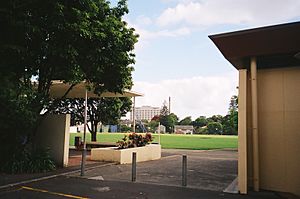
St Peter's College and Christian Brothers House
This Catholic boys' school was designed by William Henry Gummer and built between 1939 and 1944. It's located on land that was given by the Outhwaite family.
Former Methodist Training College
This impressive brick building from the 1920s was designed by James Hodge White. It used to be a training college for the Methodist church.
Phoenix Gardens
This is a tall apartment building that was built in the 1990s.
Auckland Bowling Club
The Auckland Bowling Club was started in 1861 and is the oldest bowling club in New Zealand! Its fields are in the Auckland Domain.
Grafton Volcano
In 2011, scientists found a "forgotten volcano" right under Grafton! While people knew that the nearby Auckland Domain was a volcano crater (about 50,000 years old), it turns out that most of Grafton sits on an even older volcano crater.
Famous People from Grafton
- Chief Pōtatau Te Wherowhero lived in the Auckland Domain in the late 1840s. He was visited by Governor George Grey there.
- Gustavus von Tempsky, a famous soldier, lived on Grafton Road in the early 1860s.
- The Outhwaite family, who owned the land that is now Outhwaite Park, lived in Grafton for almost 85 years.
- The famous pilot Jean Batten stayed with her brother in Grafton during the 1930s.
- The painter Max Gimblett grew up in Grafton in the 1940s. Another painter, Don Binney, used to rent a studio here in the 1990s.
- Pauline Kumeroa Kingi CNZM is a notable person who lives in Grafton today.



